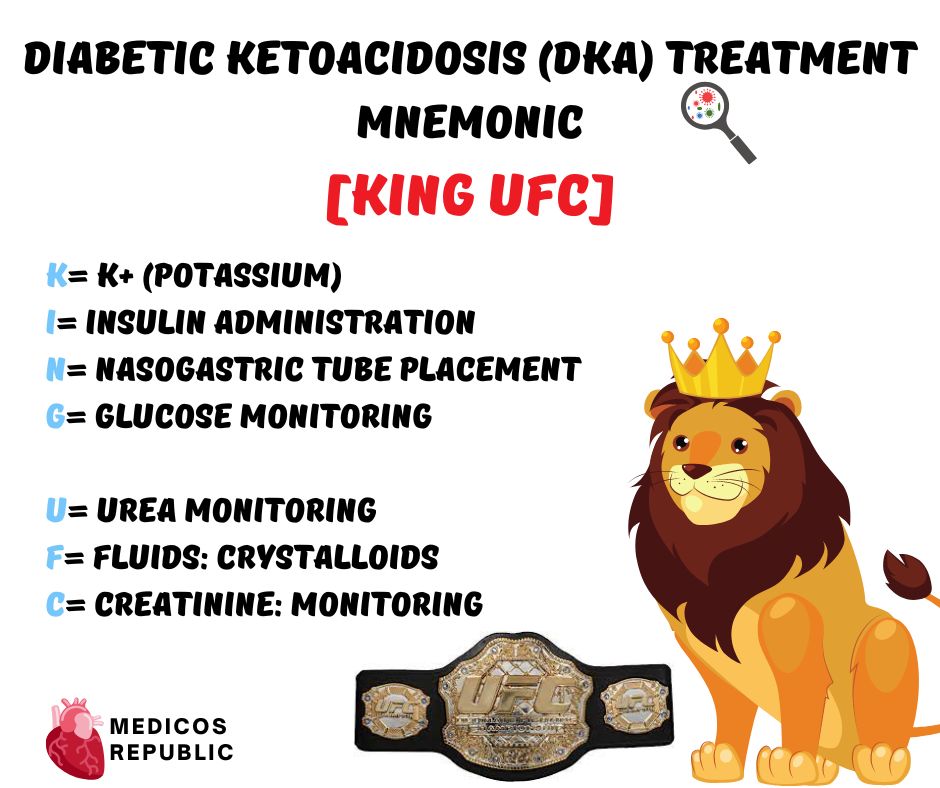As medical professionals, we encounter Diabetic Ketoacidosis (DKA) patients frequently in our wards and at the Accident and Emergency Department. Therefore, we must remember the DKA treatment at our fingertips with the aid of mnemonic tools that streamline our approach to critical interventions. Enter the mnemonic “KING UFC,” an invaluable diagnostic tool to manage this life-threatening metabolic derangement. Through this mnemonic, we consolidate essential steps for DKA management: Potassium replacement, Insulin administration, Nasogastric tube placement, Glucose monitoring, Urea monitoring, Fluids (crystalloids), and Creatinine monitoring. The mnemonic’s succinct yet comprehensive structure equips healthcare professionals with a high-yield framework to swiftly address the complex metabolic characteristic of DKA, thereby optimizing patient outcomes through a strategic and systematic approach.
In the field of acute care, the “KING UFC” mnemonic signifies a high-yield clinical approach tailored for medical professionals. By encapsulating critical components of DKA management, the mnemonic empowers doctors and nurses to rapidly identify and address ketosis, electrolyte imbalances, and insulin deficiencies. This comprehensive and memorable tool ensures our clinical interventions are well-aligned with evidence-based guidelines, optimizing patient outcomes.
We, here at the Medicos Republic, hope that you find this medical mnemonic useful in memorizing the DKA treatment. 🙂
DKA Treatment Mnemonic: “KING UFC”
Here’s the “KING UFC” mnemonic tabulated for easy reference:
| Mnemonic Component | Treatment Step |
|---|---|
| K | K+ (Potassium) |
| I | Insulin administration |
| N | Nasogastric tube placement (if the patient is comatose) |
| G | Glucose monitoring once serum levels drop |
| U | Urea monitoring |
| F | Fluids: crystalloids |
| C | Creatinine: monitoring |

BONUS: Precipitating factors of DKA Mnemonic
Here’s a quick mnemonic for memorizing the precipitating factors of Diabetic Ketoacidosis (DKA): FIVE I’s
- Infection
- Ischemia (cardiac, mesenteric)
- Infarction
- Ignorance (poor compliance to medications)
- Intoxication
Happy learning, folks! 🙂

![Diabetic Ketoacidosis (DKA) Treatment Mnemonic [KING UFC] 1 DKA Treatment Mnemonic](https://www.medicosrepublic.com/wp-content/uploads/2023/08/Diabetic-Ketoacidosis-DKA-Treatment-Mnemonic-KING-UFC-1-696x391.jpg)



![Carcinoid Syndrome Mnemonic [Easy-to-memorize] Carcinoid Syndrome Mnemonic](https://www.medicosrepublic.com/wp-content/uploads/2024/08/Carcinoid-Syndrome-Mnemonic-Easy-to-memorize-218x150.jpg)

![Stages of Neurocysticercosis Mnemonic [Vegans Can’t Get Neurocysticercosis] Stages of Neurocysticercosis Mnemonic](https://www.medicosrepublic.com/wp-content/uploads/2023/08/Stages-of-Neurocysticercosis-Mnemonic-Vegans-Cant-Get-Neurocysticercosis-1-218x150.jpg)
![Paediatrics at a Glance 4th Edition PDF Free Download [Direct Link] Paediatrics at a Glance 4th Edition PDF](https://www.medicosrepublic.com/wp-content/uploads/2023/07/Paediatrics-at-a-Glance-4th-Edition-PDF-Free-Download-1-150x150.jpg)
![Braunwald’s Heart Disease: A Textbook of Cardiovascular Medicine 9th Edition PDF Free Download [Direct Link] Braunwald's Heart Disease 9th Edition PDF](https://www.medicosrepublic.com/wp-content/uploads/2018/12/Braunwalds-Heart-Disease-9th-Edition-PDF-1-150x150.jpg)
![CURRENT Diagnosis and Treatment Critical Care 3rd Edition PDF Free Download [Direct Link] CURRENT Diagnosis and Treatment Critical Care 3rd Edition PDF](https://www.medicosrepublic.com/wp-content/uploads/2019/04/CURRENT-Diagnosis-and-Treatment-Critical-Care-PDF-150x150.jpg)
![Atlas of Gynecologic Surgical Pathology 3rd Edition PDF Free Download [Direct Link] Atlas of Gynecologic Surgical Pathology 3rd Edition PDF](https://www.medicosrepublic.com/wp-content/uploads/2018/09/Atlas-of-Gynecologic-Surgical-Pathology-3rd-Edition-PDF-Free-Download-150x150.jpg)
![CliffsNotes NCLEX-RN Cram Plan 2023 PDF Free Download [Direct Link] CliffsNotes NCLEX-RN Cram Plan PDF](https://www.medicosrepublic.com/wp-content/uploads/2023/05/CliffsNotes-NCLEX-RN-Cram-Plan-150x150.jpg)
![Essential Respiratory Medicine 1st Edition PDF Free Download [Direct Link] Essential Respiratory Medicine 1st Edition PDF](https://www.medicosrepublic.com/wp-content/uploads/2019/03/Essential-Respiratory-Medicine-1st-Edition-PDF-Free-Download-150x150.jpg)
![Diagnostic Microbiology of the Immunocompromised Host 2nd Edition PDF Free Download [Direct Link] Diagnostic Microbiology of the Immunocompromised Host 2nd Edition PDF](https://www.medicosrepublic.com/wp-content/uploads/2019/03/Diagnostic-Microbiology-of-the-Immunocompromised-Host-2nd-Edition-PDF-Free-Download-150x150.jpg)
![First Aid for the Match 5th Edition PDF Free Download [Direct Link]](https://www.medicosrepublic.com/wp-content/uploads/2023/02/First-Aid-for-the-Match-5th-Edition-PDF-Free-Download-150x150.jpg)
![Diagnostic Pathology: Breast 3rd Edition PDF Free Download [Direct Link] Diagnostic Pathology Breast 3rd Edition PDF](https://www.medicosrepublic.com/wp-content/uploads/2022/08/Diagnostic-Pathology-Breast-3rd-Edition-PDF-Free-Download-150x150.jpg)
![Instant Anatomy 5th Edition PDF Free Download [Direct Link]](https://www.medicosrepublic.com/wp-content/uploads/2018/12/Instant-Anatomy-5th-Edition-PDF-Free-Download-150x150.jpg)




